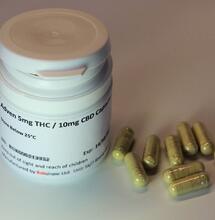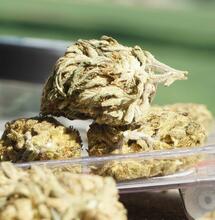From Water Hash

|
Purple Emergency bubble. |
How Water Hash Works
The water hash method uses a combination of water, ice, and agitation to separate glands from the plant material. Ice, water, and plant material are placed in a bucket that has been lined with bags. These filtration bags are similar to the screens used in making kief. They filter the glands by micron size, separating the trash from the hash. A micron is one-millionth of a meter, or .001 millimeters. The material is stirred to knock the trichomes free. Plant material is trapped and floats in the top bag, while the glands, which are heavy and sink, are collected in the lower bag.
Ready-made systems use multiple bags that sort the glands into grades. Unlike kief making, the material is separated in one step rather than through repeated sieving. Usually the material is processed once. Some commercial hash makers process it a second time to capture more of the THC.
The ice serves a dual purpose, as an agitator against which the material is rubbed, and to make the material very cold, so the glands and the plant material remain brittle. After the material is agitated in ice water, it is allowed to settle. Then the bags are separated, and the glands are removed from each one. After the water hash is dried, it is ready to smoke. (See the “Ask Ed Grow Tip: Hash Making” video on YouTube.)
Ready-Made Bags
The Ice-O-Lator
|
The Ice-O-Lator agitates the vegetation in ice water to remove glands. Photo: Pollinator |
Mila Jansen’s first invention was the Pollinator. Her interest in improving hash-making methods also led her to develop the ready-made water extraction system called the Ice-O-Lator.
According to Mila, experiments with a water process did not yield much, literally, until a product called the Extractor was released in 1997. After trying it out, Mila carried the Extractor for a short time in her sales line. While this machine was a conceptual breakthrough in water hash processing, the Extractors that were sold had mechanical difficulties and left Mila dealing with unhappy customers who had broken-down systems within a year.
This led Mila to experiment with her own design, using the principles by which the Extractor worked. She created a simpler, manual system that is called the Ice-O-Lator. This bag system first became available in 1998. It has since been refined and expanded to include three standard sizes that can process 200 to 1200 grams of material at a time, plus a travel Ice-O-Lator and a large system that can be used in the washing machine. Pollinator also makes its own washing machines in five-gallon (19-liter) and twenty-gallon (76-liter) sizes.
The Ice-O-Lator bag system consists of two bags, which line a sealable bucket of the appropriate size. Ice and water are added and then the dried material is placed in the bucket. A standard kitchen mixer affixed through the bucket’s lid agitates the material. The top bag holds all of the vegetative matter. Glands filter through the silk screen of the first bag and collect in the finer screen of the second bag. The remaining water in the bucket will have particulate vegetative matter, including some nutrients that make it good for watering houseplants or vegetable gardens.
Bubble Bags
|
Bubble Bags create different grades of water hash through a series of finer and finer screens, from 25 to 220 microns. |
Bubble Bags are the design of Fresh Headies in Canada. Bubbleman, the head hash master of Fresh Headies, has traveled extensively, spreading the good word on water hash. He can also be found moderating in online forums on this topic.
Bubble Bags are available in one-gallon (0.38-liter), five-gallon (19-liter), and twenty-gallon (76-liter) sizes. The two larger sizes can be bought as a three-bag or eight-bag filtration system. The eight-bag system separates hash into finer categories. The size difference between just-ripe THC glands and overly mature or premature ones allows them to be separated into grades.
Bubble Bags work in a similar but slightly modified way from the Ice-O-Lator system. First, the coarse filter bag is secured in a bucket, and the water, ice, and plant material are added. The material is agitated using a kitchen mixer or a drill with a paint-mixing attachment. After the material settles, the starter bag is pulled out and squeezed. The bulk of the plant material now held in this bag is set aside. This material can be processed again. The resulting product will be lower grade, suitable for cooking. Line the empty bucket with the additional bags. The finest bag goes in first, so it will be on the bottom. The green water is poured into the bucket, lined with the filtering bags. Pull the bags out one by one, and collect the material in the bottom of each one. Allow the kief to dry. Toss the water out or use it for watering plants.
Homemade Bags
It is possible to make your own bags, or to make a smaller amount of water hash without using bags at all. To make bags, acquire silk screen in the appropriate mesh size. Standard silk-screen material is available in several size increments between the desired 100 to 150 strands per 25.4 mm.
The screen must be attached to a tightly woven, water-resistant material (nylon works well) so that the silk screen forms the bottom of the bag. Multiple bags can be made with different screening levels in the 50- to 150-micron range for separating the water hash by quality.
The finest screen produces the purest hash. Multiple bags should be designed to fit inside one another, with the finest mesh bag being the largest, and the coarsest mesh bag being the smallest. A separate bag made for coarse filtering (200–250-micron-sized gaps) is also good for separating out the bulk of the vegetation in the first phase. This bag should line the bucket. It does not get layered with the other bags, so it should be as large as the bucket allows.
The Bucket Method
The essentials of the water hash method are the same, whether using a ready-made system or working from your own homemade bags.
Equipment:
- Ice
- Cold water
- Hydrogen peroxide
- 2 buckets with at least one lid
- Dried trim/bud/leaf material
- Handheld mixer or drill with paint-mixing attachment
- Ready-made bag system or homemade bags
- Long rubber gloves
- Large towel
- Roll of paper towels
- Spoon or plastic card
Method
First, the buckets and equipment should be cleaned and sterilized. Mix 295 mL of 3% hydrogen peroxide per liter of water to make a rinse.
If you are using a bag in the first round, place this bag in the bucket. Add equal amounts of ice and water until the bucket is two-thirds full. Add the prepared plant material. Wearing the long rubber gloves, use your hands to submerse it evenly in the ice water. Up to 100 g of plant material can be used in a 19-liter bucket. If a kitchen mixer is being used, holes are punched in a bucket lid to accommodate the mixing attachments. This keeps the material from sloshing out while it is being agitated. It also allows the mixer to run hands-free.
Using the tool of choice (kitchen mixer or drill with paint-mixing attachment), agitate the material for 15 minutes, and then allow the mixture to settle. If using a ready-made system, the speed recommended in the instructions should be used. As a general rule of thumb, lower speeds work well when mixing amounts under 19 liters. Medium to high speeds are better when using a system that is 19 liters or larger. As it is mixed, the material becomes frothy. You may want to remove the suds before recommencing. Blend the material up to four times for 15 minutes at a time. Mixing the material more times produces higher yields, but also results in more particulate vegetative matter. Longer times produce less pure results, especially if multiple bags aren’t separating the hash into grades. When using a single collection mechanism, a shorter time should be used on the first round. After this hash is collected, the plant material can be reprocessed using a longer mixing time. Multiple bags allow the material to be processed all at once without sacrificing a high-grade collection.
How to Make Water Hash (Bubble)
Once the last mixing round is completed, let the mixture sit for at least 30 minutes. This allows the glands time to sink into the collection filters. If all of the ice has melted, more can be added. In cold weather, the bucket can be set outside to keep the mixture cold. Once the material has settled, it is time to separate out the glands. If the agitation has been done inside a bag, pull out this bag, removing the bulk of the plant material. The bucket now contains green water with silt in the bottom. This silt is the water hash and a small amount of particulate vegetative matter.
Line the second bucket with the collection bag or bags. The finest mesh bag goes on the bottom, so it is added to the bucket first. The coarsest bag is the last bag added, so it is the top layer. The first bag has separated out everything over the 200–250-micron size, depending on its mesh size. Now the successive layers of the bag will do the grading for you. Pour the water into the bucket that is lined with the filter bags. Slowly lift out each bag, allowing time for the water to drain. Be patient. If the entire bottom of the bag seems to be clogged, it may be necessary to reach in and gently push some material to the side. Stir up the material as little as possible. After each bag is removed, lay it on the towel and pat off excess water. More water can be removed by wrapping it with towels and squeezing it. The inside of each bag contains some tan to brown silt-like material. Carefully arrange the bag so that the material is accessible. Blot the material off with a paper towel. Remove it from the bag using a credit card or a spoon. If multiple bags were used, keep the grades separated. Place the material in a flat-bottomed bowl, or on a plate or other surface where it can be left to dry, then put it in a cool, dark place where it will get some airflow, but won’t blow away once dry. The material will dry in about 12 hours, but allow a full week to dry and cure fully. Even if some material is used sooner, allow the moisture to evaporate from the remaining material so it is not susceptible to mold.
The Coffee Filter Method
This method works well for small-scale water hash production and uses common kitchen equipment. Chop the plant material to a coarsely ground consistency. Cone-type coffee makers look like a pointier version of a standard coffeemaker basket. They are inexpensive and are available in stores or on the web. The #4 size or larger is recommended. Both reusable and disposable filters for these cones are available at the same shops where the cone was purchased.
|
Wet water hash drying. |
This method yields nice hash, but the process is not controlled by precise micron-sized filters. There is also no final filtration of small vegetative matter, so the product is not as pure as the hash made in a bag system. Still, the water hash produced using this method equals the quality of dry-screened kief.
Equipment:
- Ice
- Cold water
- Dried plant material (coarsely ground)
- Blender
- Mixing bowl
- Colander or wire mesh strainer
- Cone-type single cup coffee maker
- Reusable metal cone coffee filter, or silk screen
- Coffee filters
- 2–3 large glass jars with tight-sealing lids
- Dish towel
- Paper towels
- Scraping tool (spoon, credit card, or business card)
Method
Place enough plant material in the blender to fill it halfway. Add ice and cold water in equal amounts until the blender is full. Turn the blender on at full speed for 45 seconds to 1 minute. Let the mixture settle. Repeat three or four times. The more times the blender is run, the higher the yield; however, more vegetative material will also become particulate and lower the purity of the results.
Pour the mixture from the blender through a colander or strainer into a mixing bowl. Bowls designed to pour, such as a pancake batter bowl or a 2-liter measuring cup work best. This step separates out the bulk of the plant material.
Now pour this water through the reusable coffee filter into the glass jars, until they are about two-thirds full. Liter-sized sealable glass canning jars work well. Material will collect in the coffee filter. This is the smaller vegetative matter. The glands are too small to stay in the reusable coffee filter and have passed with the water into the glass jars. Pour another 235–475 mL of water through the filter into the glass jars to wash out any remaining glands.
Seal the jars and place them in the refrigerator for an hour. The glands settle and form silt at the bottom of the jar. Tapping the jar lightly a few times on a tabletop helps settle some of the floating material.
Gently remove the jars from the refrigerator without stirring up the material that has collected at the bottom and pour off the top one-half to two-thirds of the water. The goal is to retain the glands that are gathered in the bottom, while removing as much water content as possible.
Set up the cone on top of a suitable container such as a liter jar. Drain the remaining water and silt through the coffee filter with a disposable filter paper. The flow of water through the filter slows as the material collects, but allow it to drain completely.
Carefully remove the paper coffee filter from the cone. Flatten it with the material inside by patting it with a towel.
Material can be dried either before or after it is collected from the coffee filter. Drying it inside the coffee filter takes a little longer, but the hash is protected from blowing away and is easier to remove from the paper when both are dry. To dry in the coffee filter, place it atop a layer of paper or cloth towels. Once it is dry split the filter along a seam.
Collect the material using a spoon or plastic or paper card. Allow the material to fully dry before pressing or storing, which takes a day or two depending on the environmental conditions and the amount being dried.
Some Tips
Use a siphon rather than a pour to remove one-half to two-thirds of the water from the container. This gives you more control and creates less turbulence, so the silt at the container bottom is not disturbed.
Use a propagation mat used to sprout seedlings—it will maintain a 23°C temperature—or a heating pad set on low. Food dehydrators set on low are another effective controlled heat source.
The Jar Shaker Method
The simplest method for making water hash is using a homemade shaker. This method is the easiest in terms of time and equipment, but it also produces the least amount of hash, and the product won’t be as pure as with methods using micron-gauged filtering bags. Manual agitation is more labor intensive, but it requires no electricity and can be accomplished anywhere that the materials can be gathered.
Equipment:
- Up to 28 grams of brittle, dry trim, bud bits, or shake
- Water
- Ice
- Sealable glass jar
- Colander or wire mesh strainer
- Slotted spoon or tea strainer
- Coffee cone (#4)
- Paper coffee filters
- Dish towel
- Paper towels
- Scraping tool (spoon, credit card, or business card)
Method
Reduce the marijuana material to a coarse powder, similar to dried cooking herbs like oregano or basil, using a marijuana or coffee grinder or blender for a very short time.
Place the material in the jar, up to one-quarter full. Half-liter, liter, and two-liter jars all work. Add equal amounts of ice and very cold water until the jar is almost full. Leave about 25.44 mm of space at the top of the jar, then seal it and shake for 10 minutes.
Pour the water/material mix into a bowl and put in the refrigerator to allow it to settle for an hour. Most of the ice may melt in this time.
Remove the floating plant material with a tea strainer or slotted spoon. The plant material can be saved and reprocessed. Manual shaking does not remove all trichomes on the first round.
Once the plant material has been removed, allow the silt to resettle at the bottom of the bowl for 15–20 minutes. Drain off one-half to two-thirds of the water slowly, with an eye to saving all of the silt-like water hash material in the bottom of the jar.
Set up the cone lined with a paper coffee filter. Pour the remaining contents of the bowl through the cone. As the water hash collects in the bottom of the filter, the water will drain more slowly. Allow all of the water to drain from the filter. Then remove the filter from the cone, allowing it to flatten with the wet hash inside. Set it on a dish towel and carefully remove as much water as possible by pressing with the towel or paper towels.
Split the coffee filter along the seam and open it like a butterfly spreads its wings. Collect the material inside using a spoon or card to scrape it loose from the paper. The material is easier to separate from the coffee filter when it is either dry or only slightly damp.
The material can dry either before or after it is removed from the filter. Even if some of the material is collected for use before the drying completes, the water hash should be allowed to air dry over a day or two to reduce the chance of mold. After the water hash is dry, it can be used, stored, or pressed.



